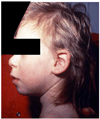Clinical radiation sensitivity with DNA repair disorders: an overview
- PMID: 19616740
- PMCID: PMC2725446
- DOI: 10.1016/j.ijrobp.2009.02.057
Clinical radiation sensitivity with DNA repair disorders: an overview
Abstract
Adverse reactions to radiotherapy represent a confounding phenomenon in radiation oncology. These reactions are rare, and many have been associated with individuals with DNA repair disorders such as ataxia-telangiectasia and Nijmegen Breakage syndrome. A paucity of published data is available detailing such circumstances. This overview describes four exemplary situations, a comprehensive list of 32 additional cases, and some insights gleaned from this overall experience. Fanconi anemia was associated with more than one-half of the reports. The lowest dose given to a patient that resulted in a reaction was 3 Gy, given to an ataxia-telangiectasia patient. Most patients died within months of exposure. It is clear that the patients discussed in this report had complicated illnesses, in addition to cancer, and the radiotherapy administered was most likely their best option. However, the underlying DNA repair defects make conventional radiation doses dangerous. Our findings support previous wisdom that radiotherapy should either be avoided or the doses should be selected with great care in the case of these radiosensitive genotypes, which must be recognized by their characteristic phenotypes, until more rapid, reliable, and functional assays of DNA repair become available.
Conflict of interest statement
Figures






Similar articles
-
Human RAD50 deficiency: Confirmation of a distinctive phenotype.Am J Med Genet A. 2020 Jun;182(6):1378-1386. doi: 10.1002/ajmg.a.61570. Epub 2020 Mar 25. Am J Med Genet A. 2020. PMID: 32212377 Free PMC article.
-
Chromosome instability syndromes.Nat Rev Dis Primers. 2019 Sep 19;5(1):64. doi: 10.1038/s41572-019-0113-0. Nat Rev Dis Primers. 2019. PMID: 31537806 Free PMC article. Review.
-
The inherited basis of human radiosensitivity.Acta Oncol. 2001;40(6):702-11. doi: 10.1080/02841860152619115. Acta Oncol. 2001. PMID: 11765064 Review.
-
Recommendations for Childhood Cancer Screening and Surveillance in DNA Repair Disorders.Clin Cancer Res. 2017 Jun 1;23(11):e23-e31. doi: 10.1158/1078-0432.CCR-17-0465. Clin Cancer Res. 2017. PMID: 28572264 Free PMC article. Review.
-
DNA double-strand break induction and repair in irradiated lymphoblastoid, fibroblast cell lines and white blood cells from ATM, NBS and radiosensitive patients.Strahlenther Onkol. 2007 Aug;183(8):447-53. doi: 10.1007/s00066-007-1683-4. Strahlenther Onkol. 2007. PMID: 17680225
Cited by
-
Hypersensitivity to chemoradiation in FANCA carrier with cervical carcinoma-A case report and review of the literature.Rep Pract Oncol Radiother. 2015 Jul-Aug;20(4):309-15. doi: 10.1016/j.rpor.2014.11.006. Epub 2014 Dec 5. Rep Pract Oncol Radiother. 2015. PMID: 26109920 Free PMC article.
-
Stereotactic Radiosurgery for Brain Metastases in Patients With a Heterozygous Germline Ataxia Telangiectasia Mutated Gene.Cureus. 2023 Apr 17;15(4):e37712. doi: 10.7759/cureus.37712. eCollection 2023 Apr. Cureus. 2023. PMID: 37206490 Free PMC article.
-
Two cases with fatal outcome following total lung irradiation for metastatic bone sarcoma.J Bone Oncol. 2013 Oct 11;2(4):174-9. doi: 10.1016/j.jbo.2013.09.002. eCollection 2013 Dec. J Bone Oncol. 2013. PMID: 26909289 Free PMC article.
-
Central Nervous System Distribution of the Ataxia-Telangiectasia Mutated Kinase Inhibitor AZD1390: Implications for the Treatment of Brain Tumors.J Pharmacol Exp Ther. 2022 Oct;383(1):91-102. doi: 10.1124/jpet.122.001230. Epub 2022 Aug 5. J Pharmacol Exp Ther. 2022. PMID: 36137710 Free PMC article.
-
Radioprotective effects of manganese-containing superoxide dismutase mimics on ataxia-telangiectasia cells.Free Radic Biol Med. 2009 Aug 1;47(3):250-60. doi: 10.1016/j.freeradbiomed.2009.04.018. Epub 2009 Apr 21. Free Radic Biol Med. 2009. PMID: 19389472 Free PMC article.
References
-
- Riesz PB. The life of Wilhelm Conrad Roentgen. Am J Roentgenol. 1995;165:1533–1537. - PubMed
-
- Weber AL. History of head and neck radiology: past, present, and future. Radiology. 2001;218:15–24. - PubMed
-
- Hall EJ. Radiobiology for the Radiologist. 5th Edition. Philadelphia: Lippincott Williams & Wilkins; 2000.
-
- Clark JG, Coley WB, Gerster JCA, Jackson E, Stengel A. Progressive medicine in the medical and surgical sciences. In: Hare HA, Appleman LF, editors. Diseases of the blood. Diathetic and metabolic diseases. Diseases of the thyroid gland, nutrition and the lymphatic system. Volume 2. Philadelphia and New York: Lea and Febiger; 1912. pp. 264–265.
-
- Gatti RA. The inherited basis of human radiosensitivity. Acta Oncologica. 2001;40(6):702–711. - PubMed
Publication types
MeSH terms
Substances
Grants and funding
LinkOut - more resources
Full Text Sources
Other Literature Sources

